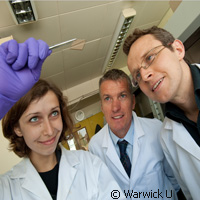Gold(en) boost for organic solar cells
A gold plated window as the transparent electrode for organic solar cells is now a reality thanks to a team of researchers from the University of Warwick in the UK. The upshot of this development, apart from its innovation, is that it could be relatively cheap because the gold used is just 8 billionths of a metre thick. Presented in the journal Advanced Functional Materials, the research was funded in part by a European Regional Development Fund (ERDF) grant. Scientists have traditionally depended on indium tin oxide (ITO) coated glass as the transparent electrode for organic solar cells, mostly because there is no other alternative. The problem with ITO is that not only is it a complex material, but it is unstable as well. It has a high surface roughness and the chances of it cracking once bent, if supported on a plastic substrate, are high. Making matters worse is that indium, the key element in ITO, is relatively short in supply and thus a costly component. Experts have long recognised that an ultra-thin film of an air-stable metal like gold would be a good substitute for ITO. However, no one was able to generate such a thin film before, particularly one that is transparent yet resilient enough for use. Dr Ross Hatton and Professor Tim Jones from the Department of Chemistry at Warwick and colleagues discovered how to generate a fast method for the preparation of robust, ultra-thin gold films on glass. According to the team, this method could be expanded for use on large area applications including solar cells. The electrodes generated by this method are chemically well defined, they say. 'This new method of creating gold-based transparent electrodes is potentially widely applicable for a variety of large area applications, particularly where stable, chemically well-defined, ultra-smooth platform electrodes are required, such as in organic optoelectronics and the emerging fields of nanoelectronics and nanophotonics,' Dr Hatton says. Not only have the researchers developed a complex-free, effective and practical method of depositing films onto glass, but they have succeeded in improving optical properties by perforating the film with small circular holes using polystyrene balls. In a related development, the Warwick team has also deposited ultra-thin gold films directly on plastic substrates. Their work could lead to genuinely flexible solar cells in the future.For more information, please visit: University of Warwick: http://www2.warwick.ac.uk/ Advanced Functional Materials: http://onlinelibrary.wiley.com/journal/10.1002/(ISSN)1616-3028
Countries
United Kingdom



